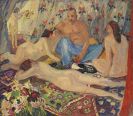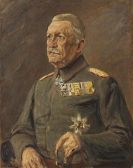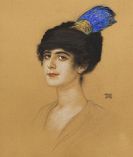
Gustav Klimt
Baumgarten/Wien
1862 -
Wien
1918
Gustav Klimt was born in Baumgarten near Vienna in 1862. In 1876 he begins his studies at the Vienna School for Applied Arts, with Ferdinand Laufberger as teacher as of 1878. In 1883 he completes his studies. Klimt earns first artistic merits during his study years by making decorative ceiling paintings that he makes for the palace of the master builder Sturny. In 1883 he makes murals and ceilings for the theatre in Fiume and for the spa hotel and the city theatre of Carlsbad in 1886. In 1887-88 he designs murals for the staircases of the Vienna "Burgtheater", and for the "Kunsthistorische Museum" (Museum of Art History) in 1891. He makes mostly team works with his brother Ernst and Franz Matsch.
Gustav Klimt, along with Josef Hoffmann, Joseph Maria Olbrich and others, founds the Vienna Secession in 1897, and is president of the group until 1905. Klimt makes numerous illustrations for the Secession's magazine "Ver Sacrum". On occasion of an exhibition with Max Klinger's Beethoven sculpture, Gustav Klimt draws the "Beethoven fries" in the Secession's building in 1901, which is one of his main works.
Already his early works show a strong stylization of his motifs and an increasing usage of decorative-symbolist ornaments. He combines a naturalist, plastic depiction of the body and the head with small mosaic parts with ornamental decorations. Among his favorite colors is gold, which he preferably uses as of 1905. The works of Gustav Klimt adjure a sensualist artificial religion, art is supposed to be purifying and elevating. The large number of female nudes that Klimt paints reflect the role of erotic elements in his works.
Gustav Klimt, who dies in Vienna in 1918, is regarded as one of the main representatives of Vienna Art Nouveau (Wiener Jugendstil).
Would you like to sell a work by Gustav Klimt?
Infos for seller








